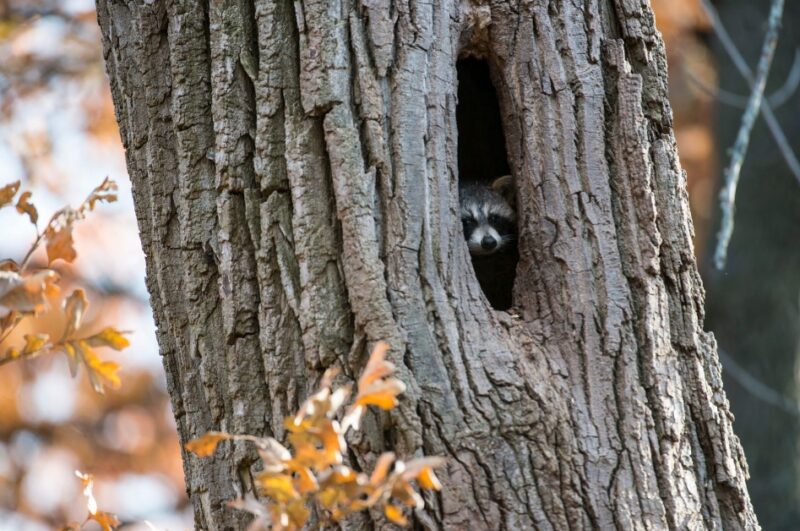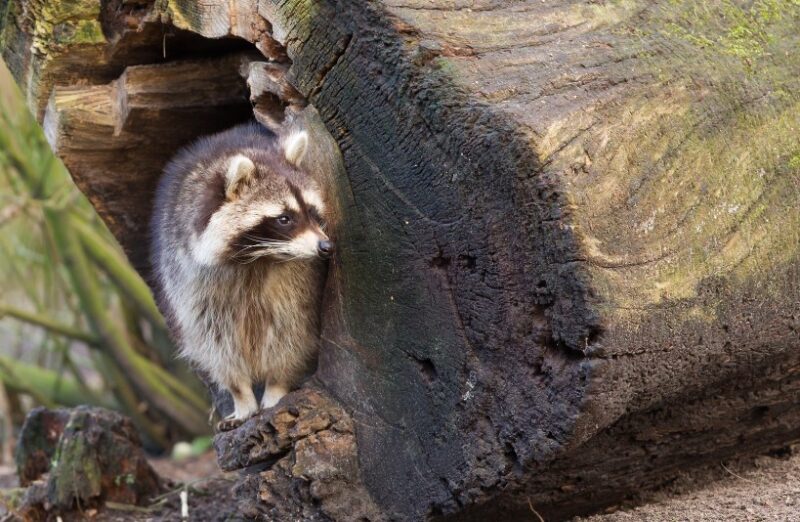What do you know about raccoon homes? Hidden amidst the lush canopies of forests and the nooks and crannies of rural landscapes, raccoons establish their enchanting dwellings. These resourceful and adaptive creatures have an uncanny ability to construct and seek shelter in various types of habitats.
From the cozy confines of tree hollows to the intricate underground burrows, raccoon homes display an intriguing blend of ingenuity and adaptability. In this article, we will embark on a journey to explore the unique characteristics of raccoon dwellings, their nesting and sheltering behaviors, the construction techniques they employ, and the remarkable adaptations that allow them to thrive in their chosen habitats.
Habitat and Natural Environment

Raccoons adapt very easily and live in a variety of habitats across North America. They thrive in diverse ecosystems such as forests, wetlands, and urban areas. While trash pandas are most commonly associated with wooded environments, they have also successfully established themselves in urban and suburban landscapes. In natural environments, raccoons take advantage of the abundance of trees, water sources, and ample food supply.
They are particularly fond of areas with mixed hardwood and deciduous forests, as these habitats provide an ideal combination of shelter and food resources. The presence of streams, rivers, and lakes is also essential for their survival, as they are proficient swimmers and rely on water sources for hydration and foraging opportunities.
Unique Characteristics of Their Home
Raccoons are highly skilled at finding shelter in a wide range of environments. Their dwellings exhibit remarkable diversity, reflecting their ability to adapt to different conditions. Whether it’s a hollow tree trunk, an underground burrow, or an arboreal nest, the dwellings possess distinct characteristics that suit their needs.
Racoon homes serve as safe havens from predators, and harsh weather conditions, and offer privacy during rest and reproduction. By capitalizing on their natural surroundings, raccoons have evolved to create homes that not only meet their immediate needs but also provide long-term sustainability.
Nesting and Sheltering Behaviors
Raccoons are nocturnal creatures, and their nesting and sheltering behaviors revolve around ensuring safety and comfort during their active hours. Their nests, dens, and burrows act as sanctuaries where they retreat for rest, breeding, and rearing their young.
The nesting process typically begins in early spring when female raccoons search for suitable locations to establish their dens. They exhibit remarkable dexterity and use their front paws to create cozy nests lined with leaves, grass, and soft materials. By adapting to their environment, trash pandas demonstrate a remarkable ability to build structures that fulfill their specific needs.
Construction Techniques
The construction techniques employed by raccoons are a testament to their resourcefulness and adaptability. In the wild, they utilize available materials and structures to build their homes. Whether it’s gathering twigs and leaves for arboreal nests or excavating burrows in the ground, they exhibit an innate understanding of their surroundings.
They rely on their nimble paws and sharp claws to manipulate objects and fashion their dwellings. Raccoons exhibit a remarkable ability to modify existing structures to suit their needs, displaying a level of architectural ingenuity that is both impressive and inspiring.
Raccoon Adaptations

Raccoons are highly skilled climbers and have adapted to their arboreal environments. Their physical characteristics, such as sharp claws, dexterous paws, and muscular build, enable them to navigate tree branches with ease. By employing their natural climbing abilities, raccoons can access tree hollows and create nests amidst the safety of foliage.
They use their flexible bodies to squeeze into narrow openings and make use of their acute senses to detect potential dangers. The adaptations that raccoons possess for tree dwelling are a testament to their ability to thrive in diverse habitats.
Structure and Features
Raccoon homes that are dens are also known as “lodges.” They are one of the most iconic dwellings associated with these creatures. They are often found in densely wooded areas and offer raccoons protection from predators and inclement weather. Dens are typically located in hollow trees, abandoned burrows, or even man-made structures like attics and abandoned buildings.
These dens consist of multiple chambers, each serving a specific purpose. The primary chamber acts as a communal living space, while separate chambers are designated for nesting, birthing, and even latrines. The complex structure of these raccoon homes showcases their organization and adaptability.
Underground Burrows and Caves
Raccoons are adept at creating intricate burrows underground, utilizing the earth’s natural features to their advantage. Burrows provide them with secure and secluded spaces for rest, protection, and raising their young. The burrowing behavior involves excavating tunnels that lead to a central nesting chamber.
These burrows are present in various terrains, including forests, marshlands, and even urban areas. Raccoons skillfully construct these subterranean networks to navigate their territories, conceal their presence, and establish a sense of safety.
Tree Hollows

Tree hollows are another favored dwelling for raccoons. These natural cavities, formed through decay or damage, offer ideal living spaces for a variety of forest-dwelling creatures. Raccoons utilize their climbing abilities to reach tree hollows, which provide shelter and protection from predators.
The adaptable nature allows them to make use of various tree species, including oak, maple, and beech, for their homes. By occupying tree hollows, they demonstrate their ability to harmonize with the existing ecosystem while benefiting from the protective qualities of these hollowed-out refuges.
Arboreal Nests and Leafy Hideouts
Raccoons exhibit a remarkable ability to construct arboreal nests, utilizing their surroundings to create secure resting places. These nests are built-in trees using a combination of twigs, leaves, and other natural materials. Arboreal nests provide raccoons with elevated platforms for sleeping, resting, and observing their surroundings.
They offer a strategic vantage point, allowing them to stay vigilant and maintain a sense of security. By creating leafy hideouts high in the treetops, raccoons showcase their adaptability to varying landscapes while enjoying the benefits of an elevated sanctuary.
Urban Homes and Human Interaction
In recent decades, raccoons have become increasingly prevalent in urban and suburban areas, adapting remarkably well to the presence of humans. The transformation of natural landscapes into concrete jungles has created new opportunities for raccoons to thrive. Urban environments offer an abundance of food sources, including trash bins, gardens, and pet food left outdoors.
The proliferation of man-made structures, such as attics and crawl spaces, provide them with ideal nesting sites and shelter from the elements. While some may consider these animals a nuisance due to their scavenging behavior and potential for property damage, it is important to understand that their presence is a result of human encroachment on their natural habitats.
Encountering raccoons in urban areas can be both fascinating and challenging, requiring responsible coexistence and measures to mitigate potential conflicts. Human interaction with urban raccoons can vary greatly, from positive encounters to instances of conflict. Humans must understand and respect the boundaries of these creatures’ territories. They are inherently curious and intelligent, which can sometimes lead to them exploring human dwellings in search of food or shelter.
However, it is essential to remember that raccoons are wild animals and not pets. Feeding them can lead to dependence and habituation, altering their natural behaviors and potentially increasing the risk of conflicts with humans or other animals. Instead, efforts are necessary to secure garbage cans, remove potential food sources, and employ humane deterrents to discourage animals from accessing human properties.
Final Thoughts
Did you know that raccoons have a higher likelihood of carrying rabies compared to opossums? However, this does not necessarily make opossums less harmful to humans.
In the intricate tapestry of the natural world, raccoons have woven themselves a niche that embodies resilience and resourcefulness. Their ability to construct diverse and enchanting dwellings reflects their remarkable adaptability and survival instincts.
Tree hollows, underground burrows, arboreal nests, leafy hideouts… Raccoon homes showcase the harmonious relationship they have with their environment. As we delve into the intricacies of raccoon dwellings, we gain a deeper appreciation for the wonders of nature and the myriad ways in which its inhabitants carve out their own spaces of enchantment.
Related Posts:
- Do Bears Have Tails? - Find Out the Truth Here
- What Sounds Do Moose Make? - A Wildlife Expert Answers
- Forest Animals – Pictures & Fun Facts On Animals…
- 10 Taiga Plants With Pictures & Facts - Boreal Forest Flora
- What Sounds Do Raccoons Make? - Meaning and How to…
- How Good Are Raccoons Senses? The Mammals Toolkit!








